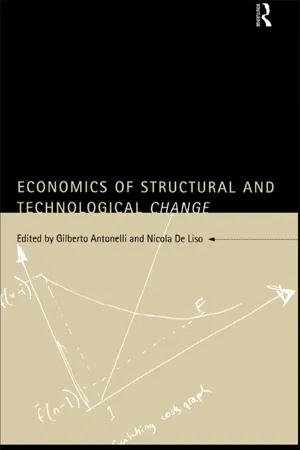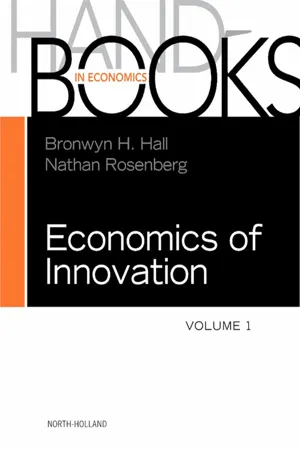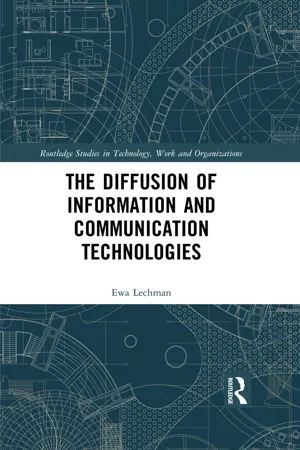Economics
Technological Change
Technological change refers to the process by which new technologies are developed and adopted, leading to improvements in production processes, products, and services. It encompasses the invention, innovation, and diffusion of technology, and has a significant impact on economic growth, productivity, and competitiveness. Technological change can also disrupt existing industries and create new opportunities for economic development.
Written by Perlego with AI-assistance
Related key terms
6 Key excerpts on "Technological Change"
- eBook - ePub
- Jay Mitra(Author)
- 2017(Publication Date)
- SAGE Publications Ltd(Publisher)
1 An Introduction to Technological Change and InnovationScope and Objectives
- An introduction to the meaning and significance of Technological Change for innovation, growth, economic and social development.
- A focus on developed economies where Technological Change has been most pronounced in the last two centuries.
- Critical appreciation of underpinning economic theories that help to explain the relationship among Technological Change, the knowledge production function, exogenous and endogenous growth, spillover effects, innovation and economic growth.
- An understanding of the contexts of Technological Change and the significance of organisational and social change generated by advances in technology and innovation.
Introduction
The connection between innovation, entrepreneurship and technical change is predicated upon the idea that their mutual interdependence leads to improved economic performance at the level of the firm, the industry, the region and the nation. Changes in technology and their use enable the creation of new products and services. The mobilisation of resources through the formation or growth of firms characterises the entrepreneurial process which brings these new products and services to the market. With the gradual diffusion of these innovations, incumbent technologies and businesses give way to new and more productive counterparts. Firms enjoy higher levels of productivity, consumers take advantage of either cheaper or better value products and services for which they may be willing to pay more, new jobs are created, we obtain a better quality of goods and services, and the gross domestic productivity of the nation increases over time. Technical advance prompts the creation of new products and services, the formation of new firms, and economic growth.Economies grow because of numerous factors that enable growth to occur. Increases in market size enable increases in gains from trade, resulting from the division of labour and competitive resource pools. Investment in physical and human capital causes economic growth. Another key source is Technological Change (Lipsey et al., 2005). Understanding how the growth process is linked to technical change, innovation and entrepreneurship is vital for any business and policy makers. Understanding the drivers and effects of innovation and entrepreneurship is critically important because we are all conscious of the fact that technical change is related to improvements in performance at the level of the individual business, the industrial sector in which the firms are located, and at the regional and national levels (Link and Siegel, 2007). - Alan Milward, S. B. Saul(Authors)
- 2013(Publication Date)
- Routledge(Publisher)
Chapter 3Technological Change
The Theory of Technological Change The Transfer of Technology The Development of Technology -Coal -Textiles - Iron and Steel - Engineering - Power Engineering - Shipbuilding - Chemicals 226 - Agriculture 233 Conclusion 244 Suggested Reading 246There is little doubt that Technological Change has been a major force in promoting economic growth over the last two centuries. Just how important is a matter for debate. Some economists have argued that it has been far more significant than simply the increased employment of capital and labour. Evidence is mounting to suggest that this is an exaggerated view and that we ought to maintain the emphasis that earlier analysts gave to variables such as the ratio of savings to national income. But however that may be, technology has clearly played a most important role in many aspects of growth — not just in raising incomes but in changing the location and size of industry, in altering the role of different raw materials, in changing social patterns of work, in altering for good and ill the quality of life itself. As for capital we must, at least, stress the importance of determining the amount of technological advance incorporated when any investment is made. Technology embraces in these contexts a wide range of activities. It may mean a new process of manufacture or a new final product. In some circumstances it can better be described as ‘know-how’ — the ability to organise and operate plant within the existing range of technological knowledge. It involves all those supplementary benefits accruing from the expansion of centres of industrial activities known as external economies. It includes the economies reaped from increases in the scale of activity and the greater efficiency derived from the process of learning a job by doing it again and again. It relates, too, to the quality of the workforce at all levels.- eBook - ePub
- Cristiano Antonelli, Nicola De Liso(Authors)
- 2002(Publication Date)
- Routledge(Publisher)
1Introduction: An appraisal of the economic analysis of Technological ChangeThe path to the last decade
Gilberto Antonelli and Nicola De Lisa1
1 Technological Change AND POLICY-MAKING
1.1 The relevance of Technological Change: a background to policy debate
Technological Change has undoubtedly been one of the most important features of the economic history of the world at least since the occurrence of the first Industrial Revolution in the last quarter of the eighteenth century in England. Since then, technical change has shaped the development of economies through the continuous occurrence of both major and minor changes.Technical change affects many aspects of both economic and social activity. It influences production in qualitative and quantitative ways, and affects employment, international trade, investment and consumption patterns. These widespread effects of technical change are such as to warrant the examination of the interaction of technical change, market forms and overall economic structure.Given the quantitative and qualitative importance of Technological Change, it is easy to understand why during the last thirty years there has been an escalation of studies concerned with it. Techniques of production now last for shorter periods; changes, however small, follow one another, and the need to capture the essence of the processes connected with Technological Change is felt more and more urgently. Both theoretical and empirical developments in the 1980s represented a turning point for economic analysis.It seems to us that these comments highlight fairly well the fact that any analysis of Technological Change is influenced by policy implications, which, as such, induce action shaped by political interests and values. Many questions can arise here.The first we consider, given its social relevance and capability of shedding light on the chains activated by policies, is unemployment. The early 1990s have been characterized by a general concern as structural long-term unemployment seems to persist and increase, and when signs of growth are visible we speak of jobless recovery. There thus emerges the question: what is the socially tolerable level of unemployment? Should governments intervene, and, if they should, how? The main alternatives in the policy arena are the following: (a) short-term flexibility as a cure mainly of labour market rigidities; (b) investment demand expansion combined with fiscal policy revitalization; (c) stimulation of new market opportunities and product innovation; (d) international competitiveness and strategic trade; (e) long-term flexibility based on the development of individual, social and technological capabilities. However, each of these solutions has a draw-back, taking also into account the composite nature of unemployment: from the effectiveness of the policy prescription to the need of increasing taxation, the risk of increasing inflation, and so on. These last points make it clear that whenever policy action is undertaken there occurs a series of reactions in the economic system, not all of which are desirable. And economic analysis should be engaged in increasing the degree of awareness of this, showing the likely scenarios in which complementarities and feedbacks share the same importance as clear-cut alternatives. - eBook - ePub
- Bronwyn H. Hall, Nathan Rosenberg(Authors)
- 2010(Publication Date)
- North Holland(Publisher)
ex ante commitment to any equilibrium notion. For example, can we identify some relatively invariant patterns in the processes of innovation? How are innovations selected? What are the relationships between technologies and forms of corporate organization? and between technical change and forms of competition? How can one characterize the ways through which relatively orderly processes of industrial change emerge out of underlying “disequilibrium” behaviors? What is the relative role of “chance” and “necessity” in evolutionary processes, and relatedly, to what extent is technoeconomic evolution path-dependently shaped by events occurring along its historical unfolding? In which ways do institutions and policies embed the processes of technological and economic change?Come as it may, as Freeman (1982) already noted, since the classics not much progress had been made for almost two centuries in our understanding of the ways new technical knowledge is generated and its impact works through the economy. Karl Marx and Joseph Schumpeter stand out as major exceptions, but they were rather lonely voices.3 The importance of Technological Change reappeared, almost by default, in Robert Solow’s growth analysis in the 1950s, but it is only over the last 40 years that one has systematically started looking—using the felicitous expression of Nate Rosenberg—inside the “blackbox of technology,” investigating the sources of novel opportunities, the dynamics through which they are tapped and the revealed outcomes in terms of advances in production techniques and product characteristics. The first part of this chapter maps and integrates such pieces of evidence. Explicit recognition of the evolutionary manners through which Technological Change proceed has also profound implications for the way economists theorize about and analyze a number of topics central to the discipline.One is the theory of the firm in industries where technological innovation is important. Indeed a large literature has grown up on this topic, addressing the nature of the technological and organizational capabilities which business firms embody and the ways they evolve over time. - Ewa Lechman(Author)
- 2017(Publication Date)
- Routledge(Publisher)
a process of active development of technology, especially designed to save labor in different areas ’ (Grinin & Korotayev, 2015, p. 52). Undeniably, technological revolution gives a positive impulse to wealth creation economy-wide; it provides a wide array of novel infrastructure and allows for organizational improvements, thus enforcing productivity shifts. Technological breakthroughs not only bring purely technically new solutions to society and economy, meaning that their influence is not purely technological, but also introduce innovations on organizational grounds and then induce significant social, economic and institutional changes. Once a technological revolution appears, it is gradually assimilated in the economy and social system, which generates great surges of development and these are then followed by transformations and modifications in social, institutional and economic spheres of life. Technological revolutions diffuse; they expand across societies and economies and, hence, generate the ‘great surges of development ’ (Perez, 2002). ‘Each (…) revolution has driven a great surge of development that takes a half of century or more to spread unevenly across the economy’ (Pereze, 2004b, p. 21). Each great surge of development , as a time-related process, unveils certain regularities, and it encompasses two consecutive periods (phases): the installation period and deployment period. The initial (installation ) phase is sometimes compared to the Schumpeterian ‘creative destruction’, which means nothing more than the fight of new ideas (technologies) against the old concepts (technologies). Schumpeter writes, ‘The process of industrial mutation (…) that incessantly revolutionizes the economic structure from within, incessantly destroying the old one, incessantly creating a new one ’ (Schumpeter, 1943, p. 83). To some extent, the period of installation is an experimental period, during which new technologies try to evade the market and are either accepted or rejected by socio-economic systems. These times of creative destruction are extremely turbulent and marked by periods of instability, during which the old regimes are being gradually eliminated from the market, while the new regimes and technological solutions abruptly irrupt and pervasively evade existing social, organizational, financial and institutional frameworks. The installation period is additionally marked by fast diffusion of innovations, and, hence, they are assimilated and then adopted by a constantly growing number of new users. During the installation phase, new industrial, new modes of production and infrastructure, new ways of doing business or even new products and inputs are widely articulated. The installation period sets up a new common sense (Perez, 2014) across the society and economy, and this period often generates huge inequalities among countries. In other words, the world becomes more differentiated and polarized because of sequentially emerging technological revolutions. The installation period is then followed by the deployment- eBook - ePub
Handbook of Environmental Economics
Environmental Degradation and Institutional Responses
- Karl-Goran Maler, Jeffrey R. Vincent(Authors)
- 2003(Publication Date)
- North Holland(Publisher)
12 Thus, in the literature, “endogenous Technological Change” and “induced Technological Change” refer to different concepts, even though the opposite of each is often described by the same phrase, that is, exogenous Technological Change. Endogenous Technological Change refers to the broad concept that Technological Change is the result of activities within the economic system, which are presumed to respond to the economic incentives of the system. Induced Technological Change refers to the more specific idea that changes in relative factor prices affect the rate and direction of innovation. In practice, papers that use the phrase “endogenous Technological Change” tend to focus on aggregate R&D expenditure and neutral Technological Change. Papers that used the phrase “induced Technological Change” or “induced innovation” tend to focus on the direction of R&D efforts and biases in Technological Change.13 See, for example, Jones and Williams (1998) , and the symposium on “New Growth Theory” in the Winter 1994 issue of the Journal of Economic Perspectives .14 See also the survey by Thirtle and Ruttan (1987) .15 In this section andSection 4, we focus separately on induced innovation and the economic forces driving diffusion. As noted above, however, the analytical distinction between innovation and diffusion is blurred in practice.16 Writing before Schumpeter, Hicks does not appear to use the word “invention” in the specific sense used by Schumpeter and adopted by later authors. Rather, Hicks uses it in a general sense encompassing both invention and innovation, as used today.17 More recently, the availability of computerized firm-level data on R&D and patents has led to an increase in parallel analyses in the industrial sector.18 See Griliches (1979) for the seminal statement of this research approach. An example of a recent application measuring the knowledge capital of firms is Hall, Jaffe and Trajtenberg (2000) .19 The recognition that the costs and benefits of R&D for the firm are affected by the appropriability problem and financing issues has led to a large literature on the effects of market structure on innovation. In the older literature, it was argued that both these problems would be overcome more easily by large firms and/or firms operating in concentrated industries characterized by market power. From these observations, it was hypothesized that innovation comes disproportionately from large firms and concentrated industries. This conjecture is known as the “Schumpeterian Hypothesis”. After much debate about what the Schumpeterian Hypothesis really means, the volume of evidence seems to show that: (1) much innovation comes from large firms in moderately concentrated industries, if only because much economic activity comes from such firms; (2) truly competitive industries (for example, construction) perform little R&D; (3) beyond minimal size and concentration, there is little evidence of any monotonic relationship between innovation intensity and either size or concentration; and (4) innovation and market structure interact dynamically in a way that is not captured by an alleged causal influence of firm size and market concentration on innovation. For an extensive survey of this literature, see Cohen and Levin (1989) . More recently, a large game-theoretic literature related to strategic R&D incentives has emerged [surveyed by Reinganum (1989) ]. This literature has two strands. One views R&D or other innovative activities in a context of continuous competition in which, for example, marginal R&D investments result in marginal cost reductions or product improvements [for example, Dasgupta and Stiglitz (1980a) , Levin and Reiss (1988) , Spence (1984) ]. The other R&D theory literature focuses on patent races , where firms compete to be the first to achieve a specific innovation goal [for example, Dasgupta and Stiglitz (1980b) , Reinganum (1982) , Fudenberg et al. (1983)
Index pages curate the most relevant extracts from our library of academic textbooks. They’ve been created using an in-house natural language model (NLM), each adding context and meaning to key research topics.





